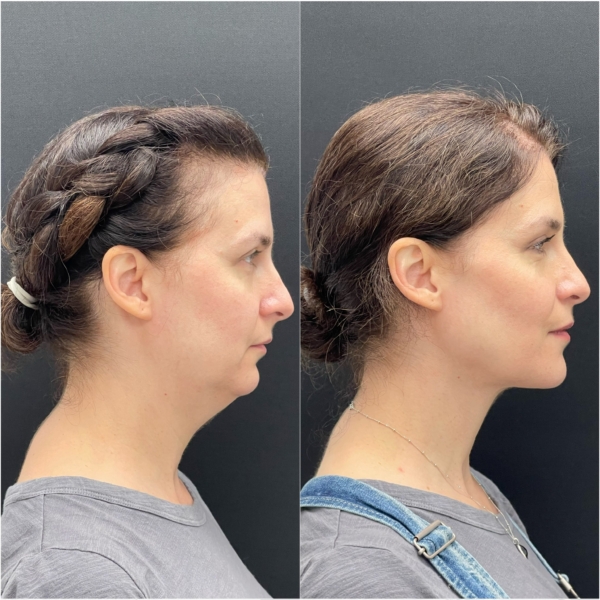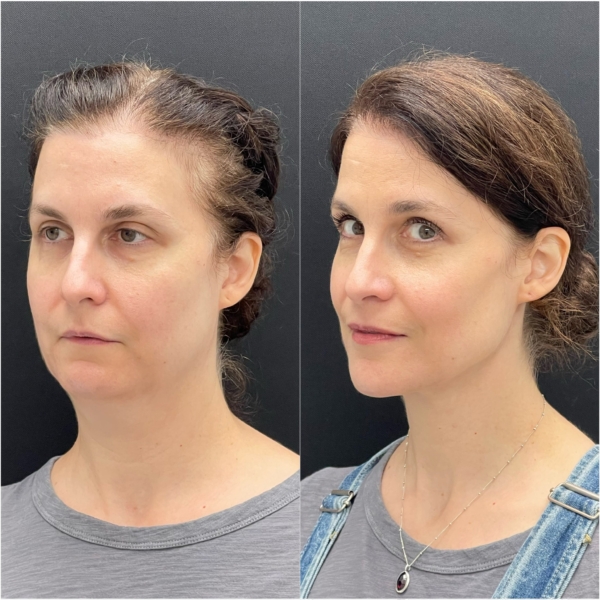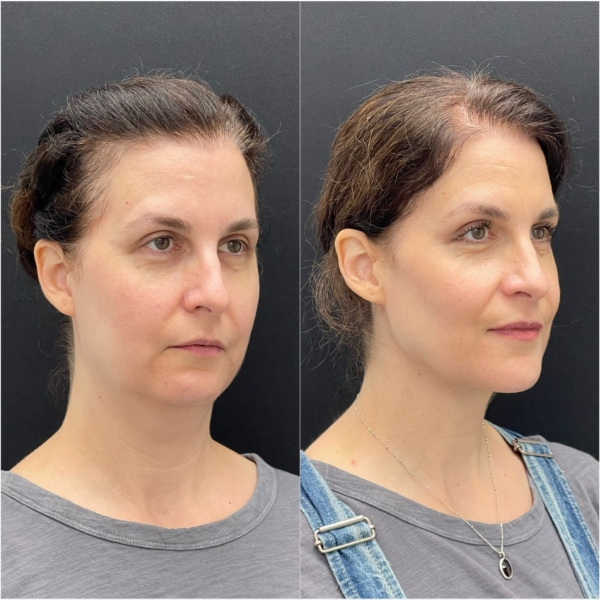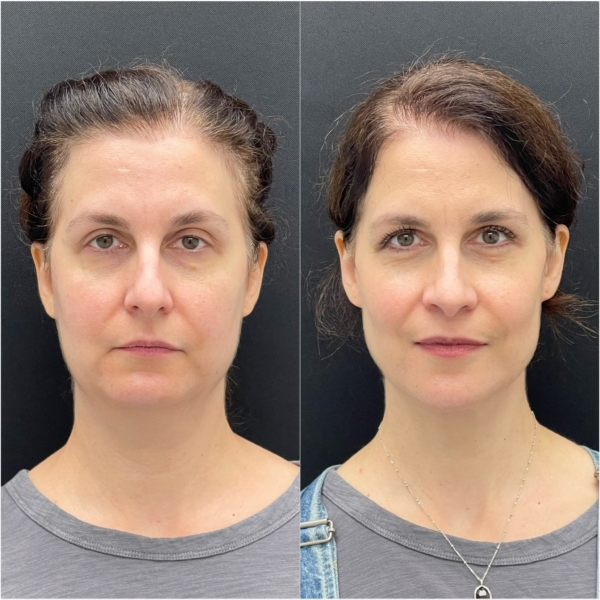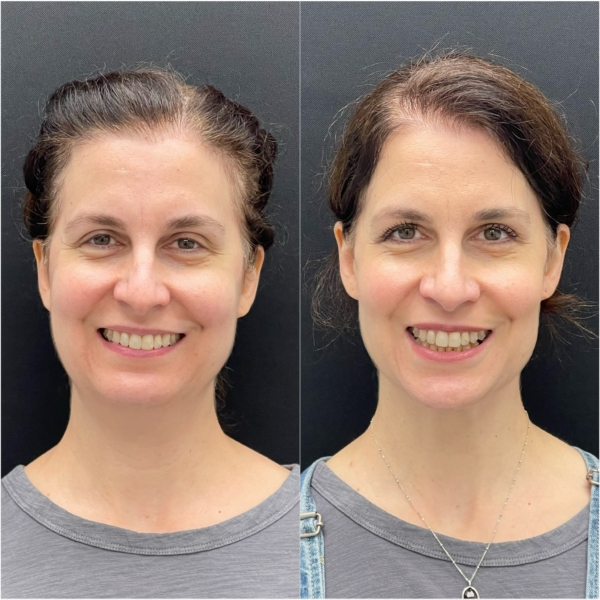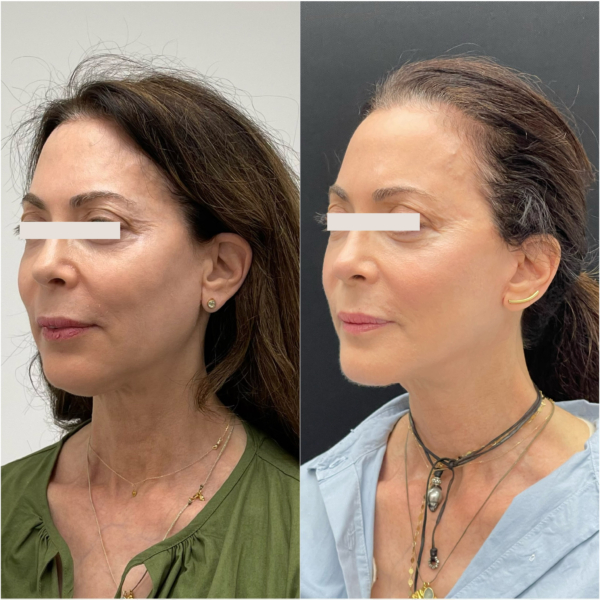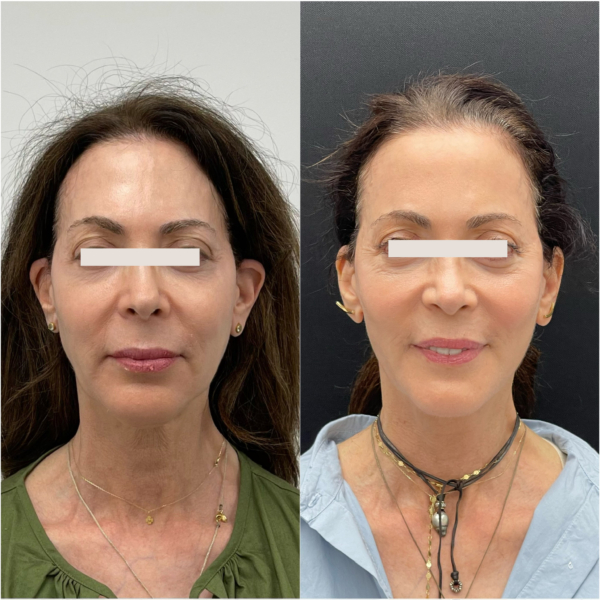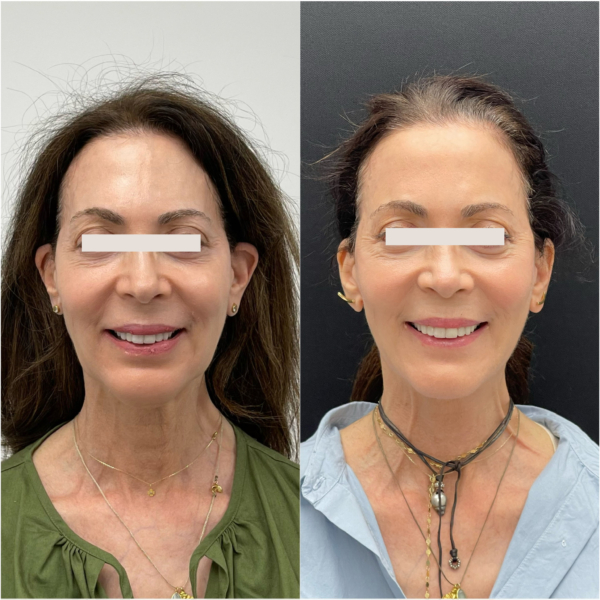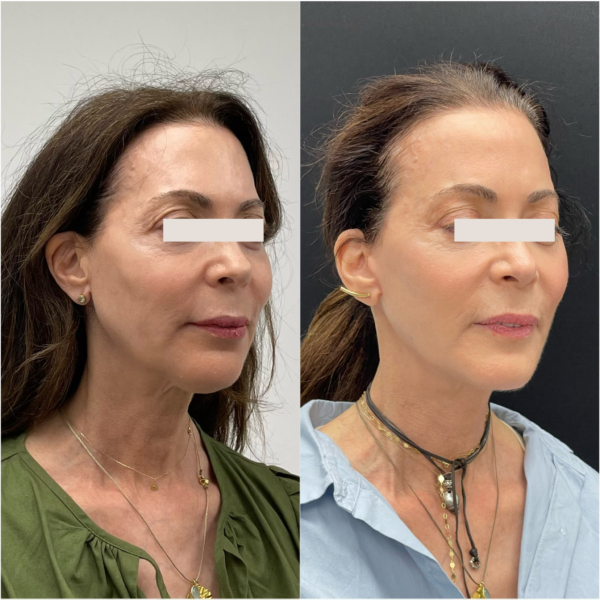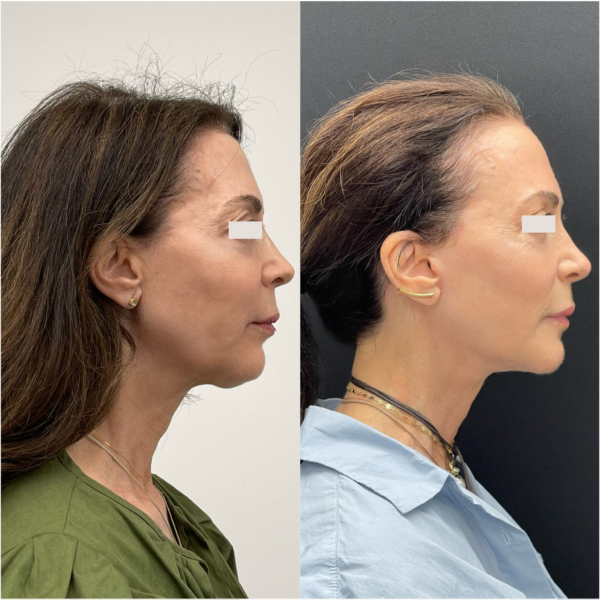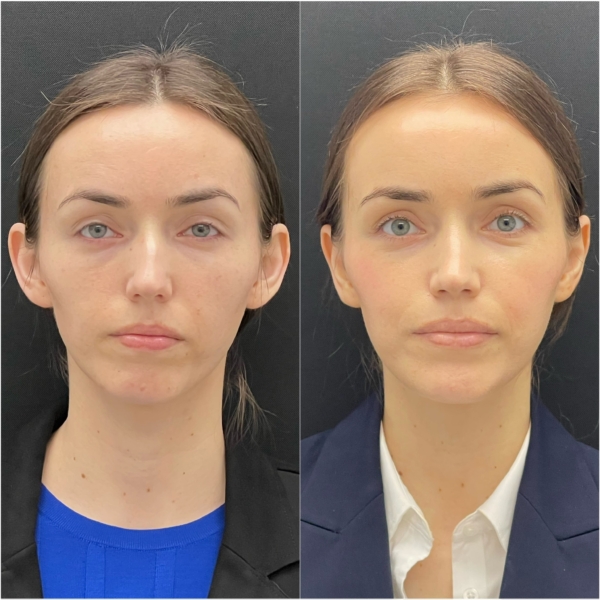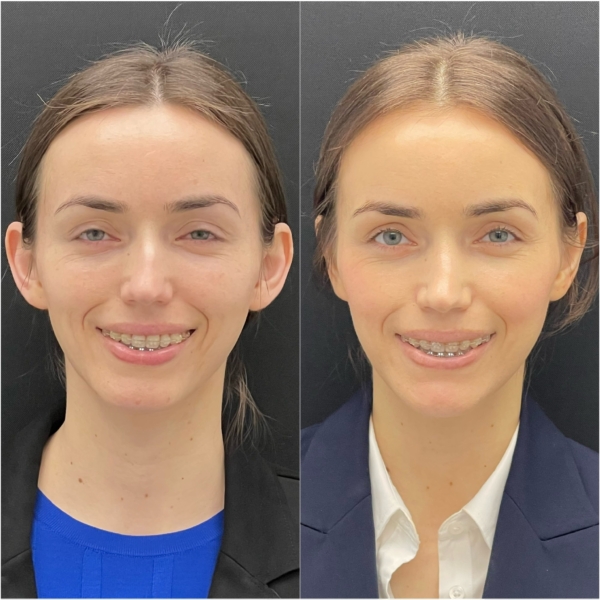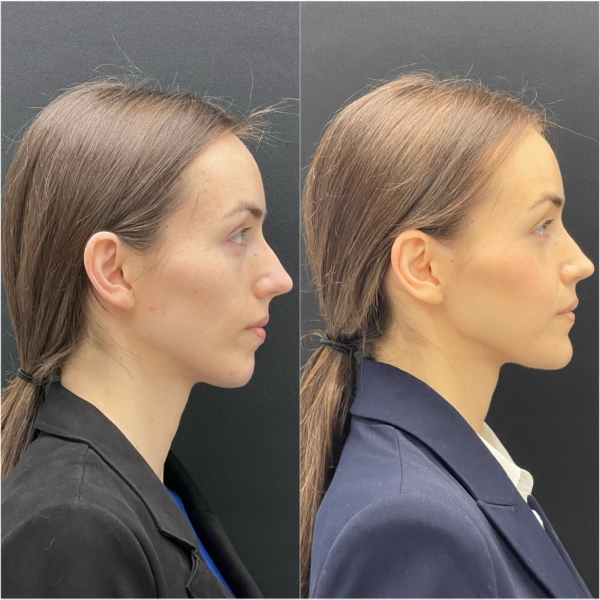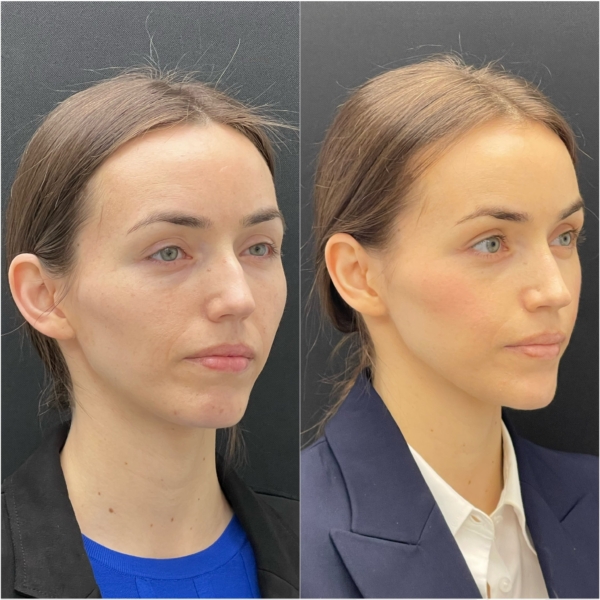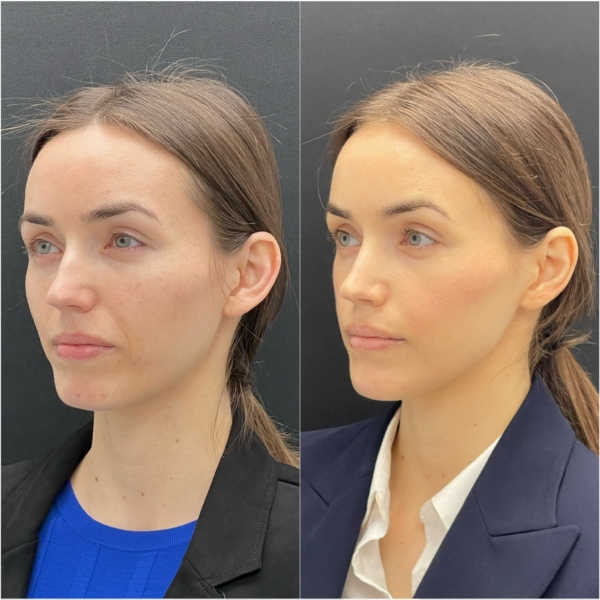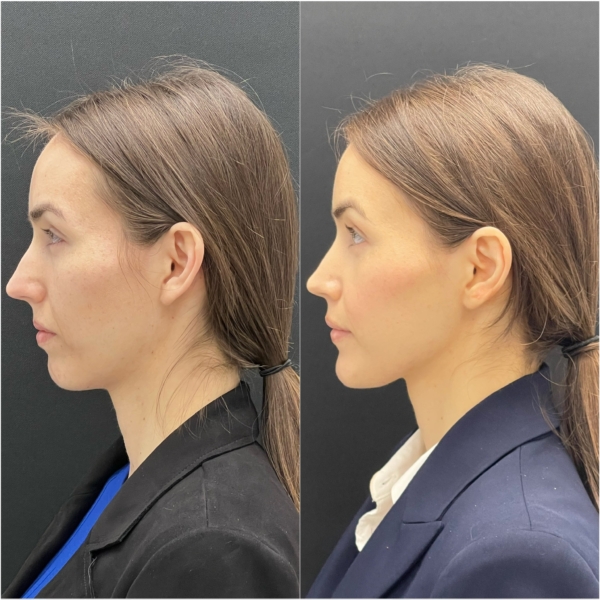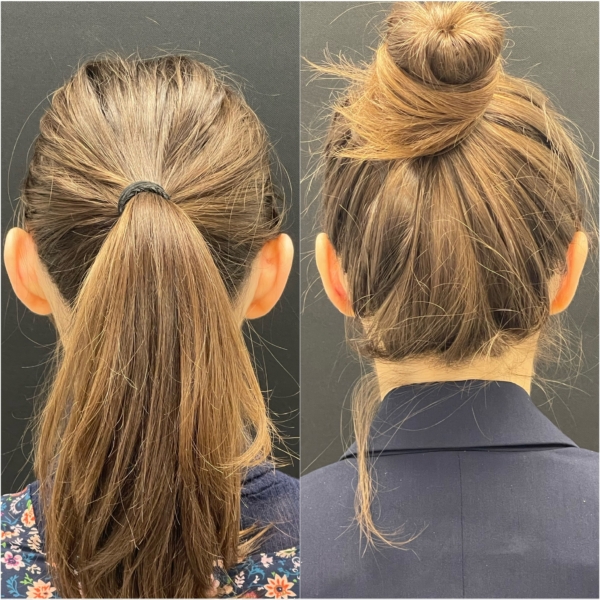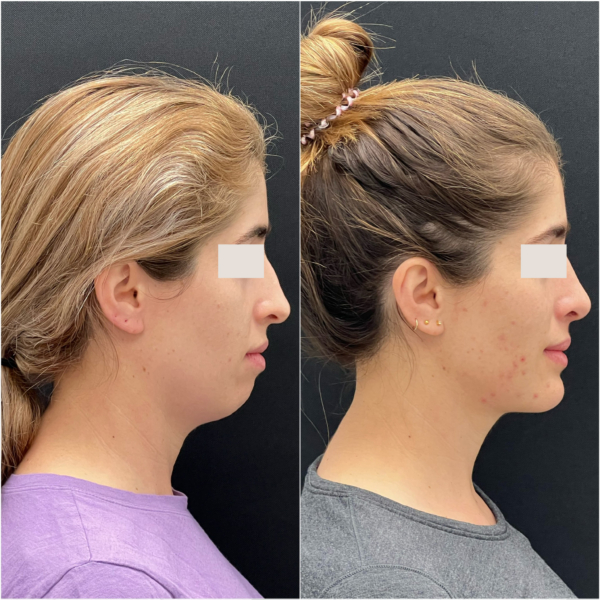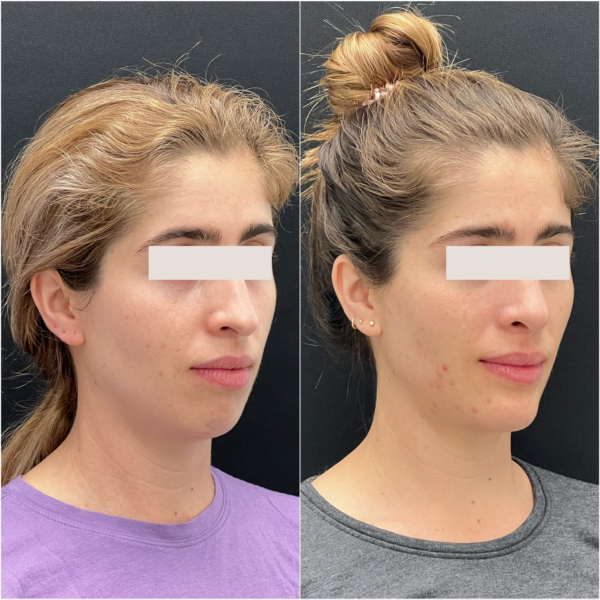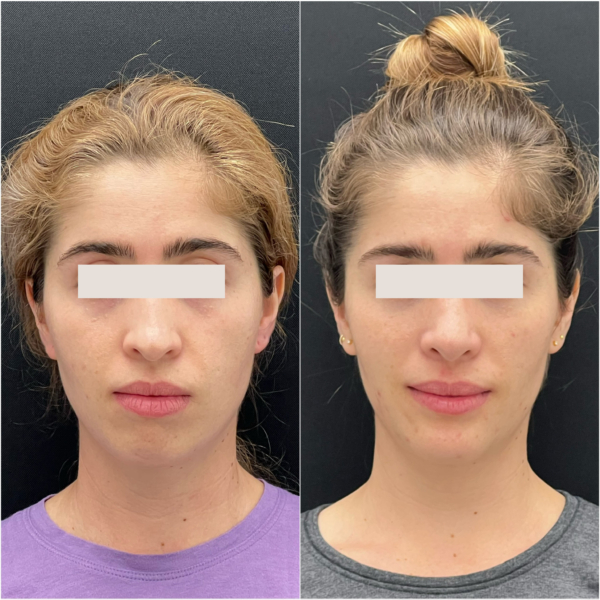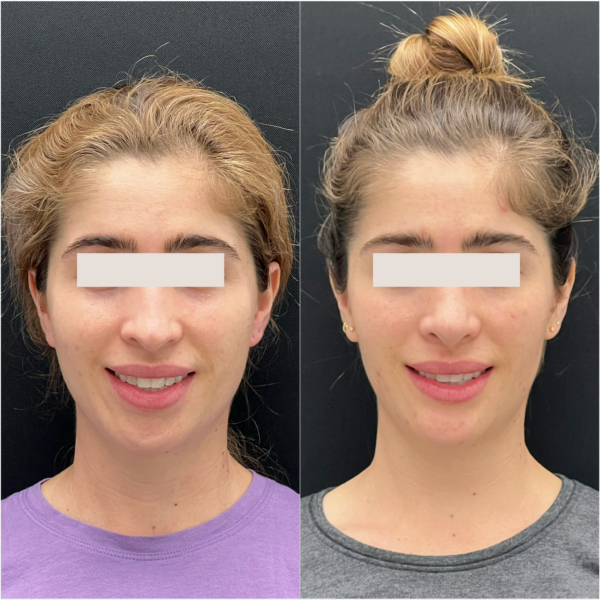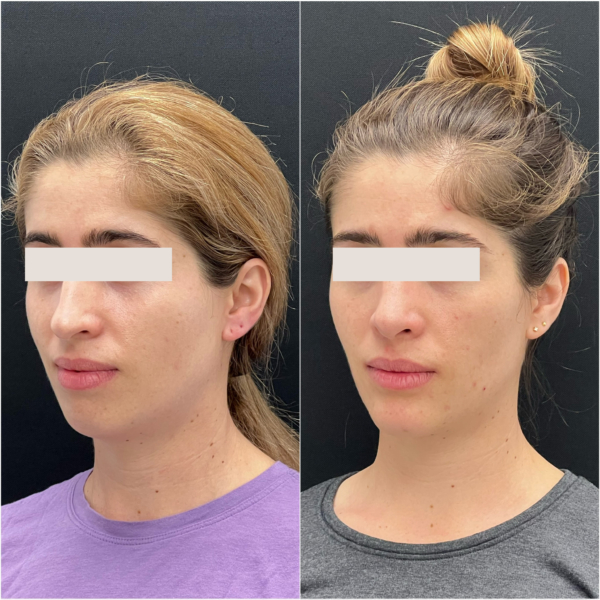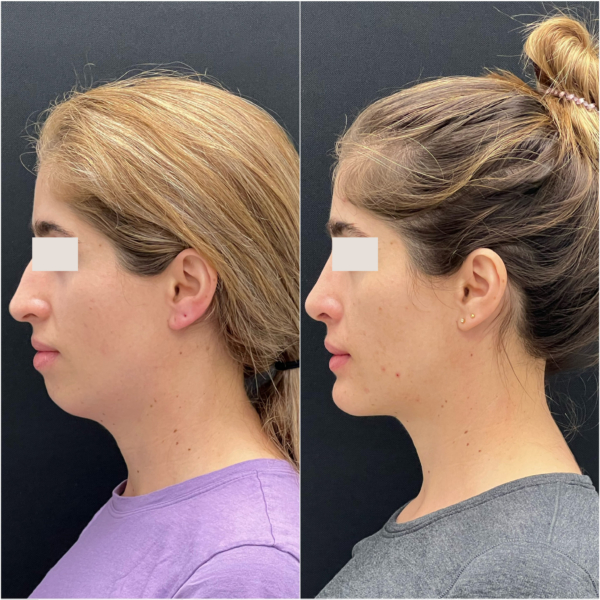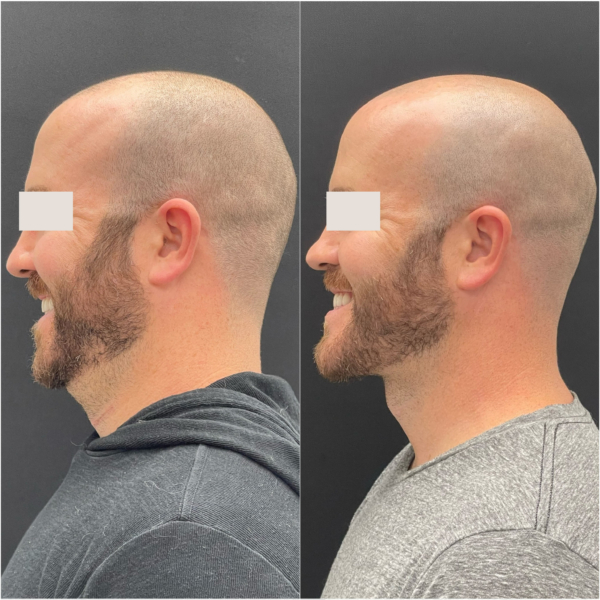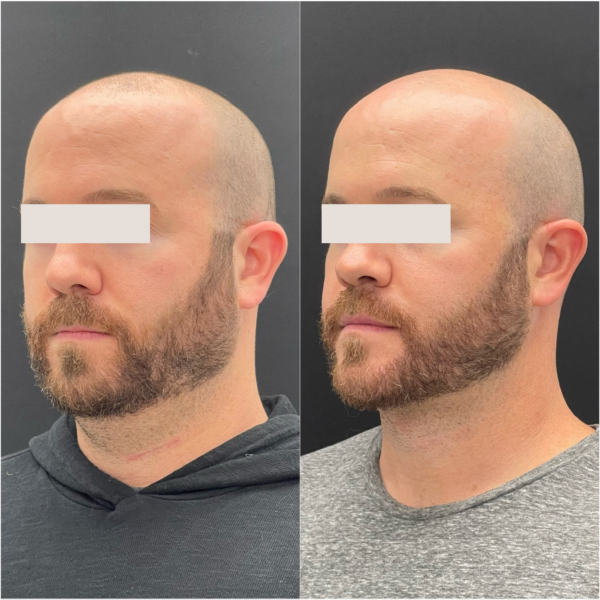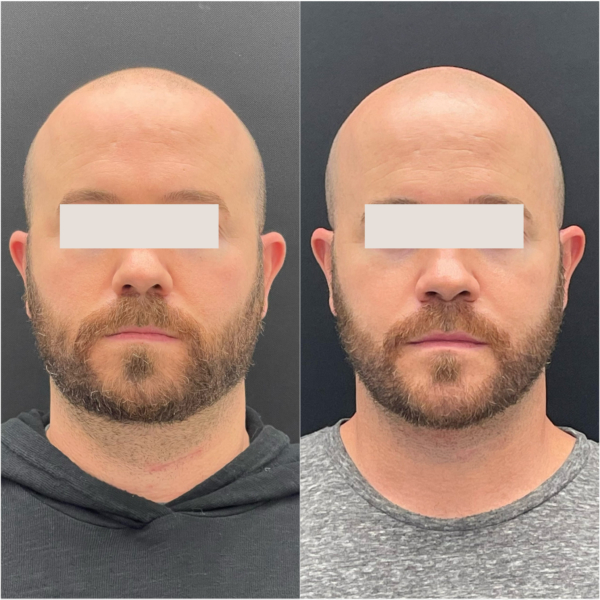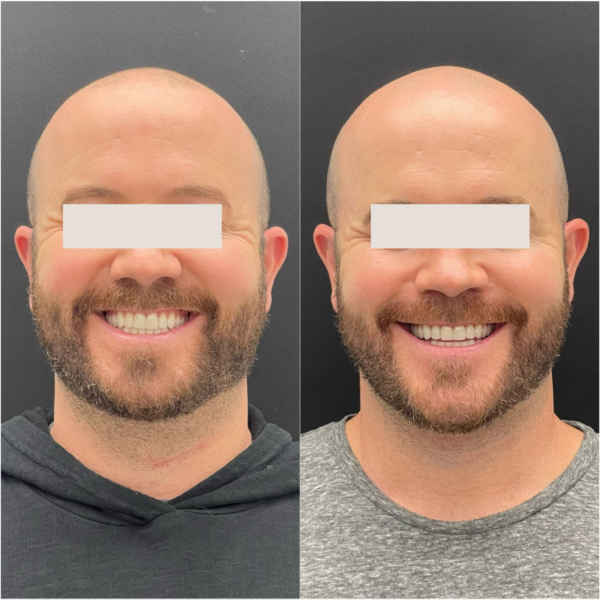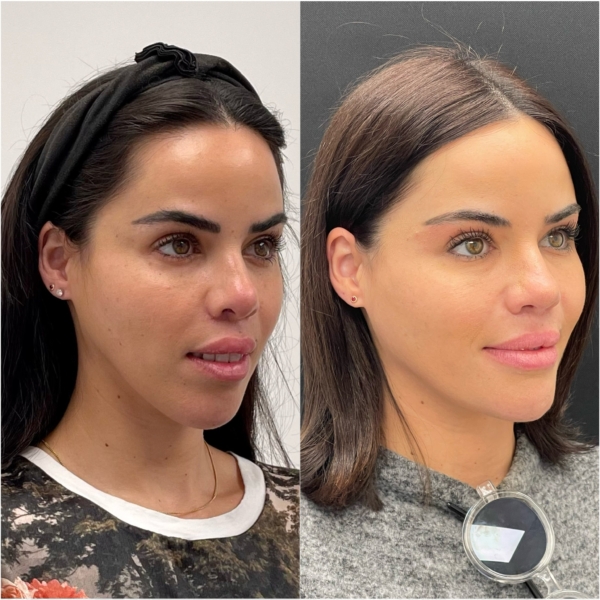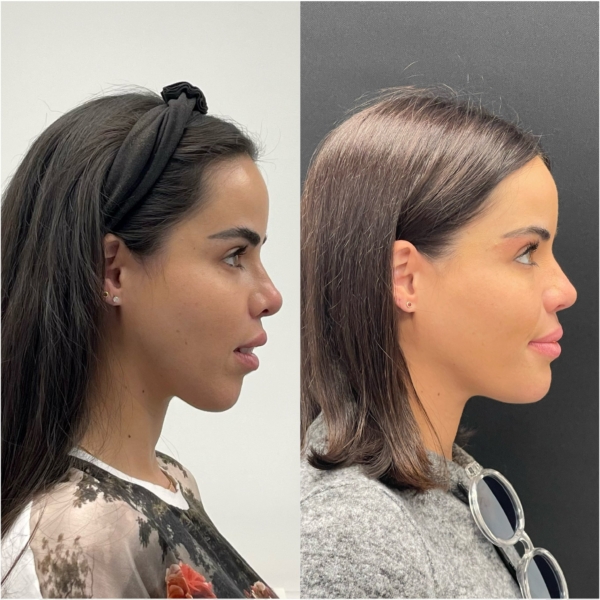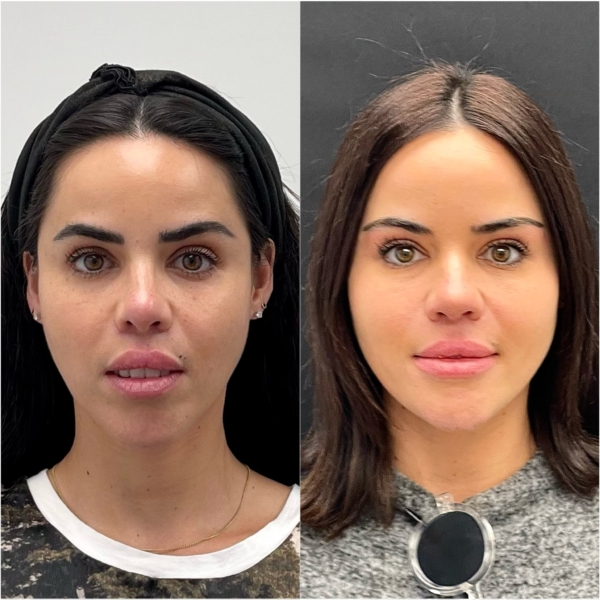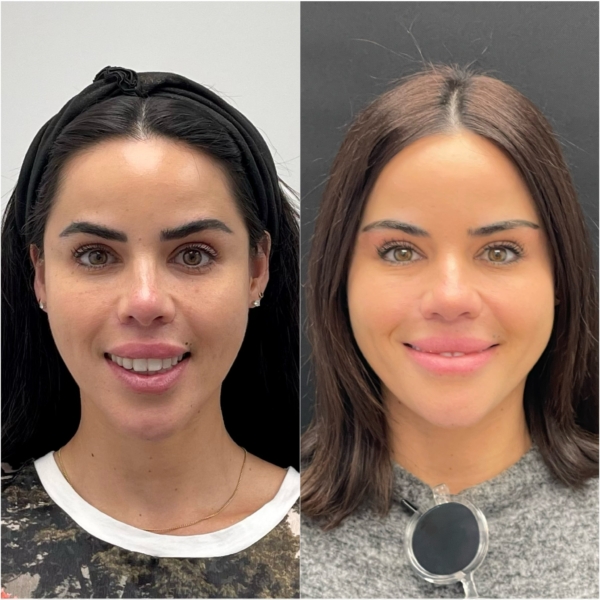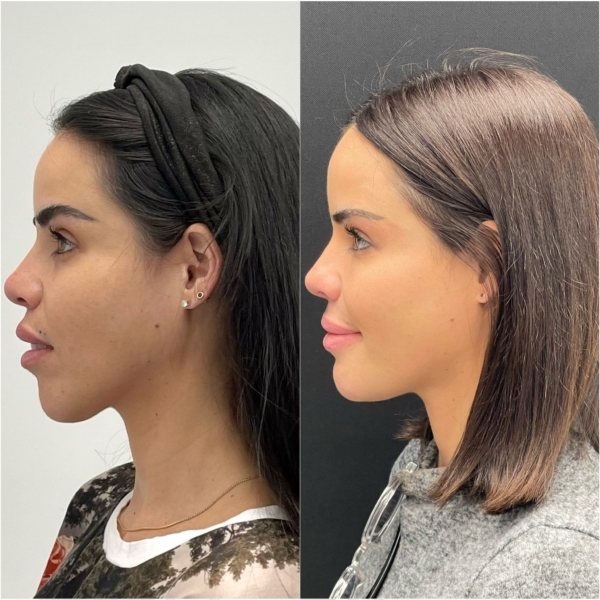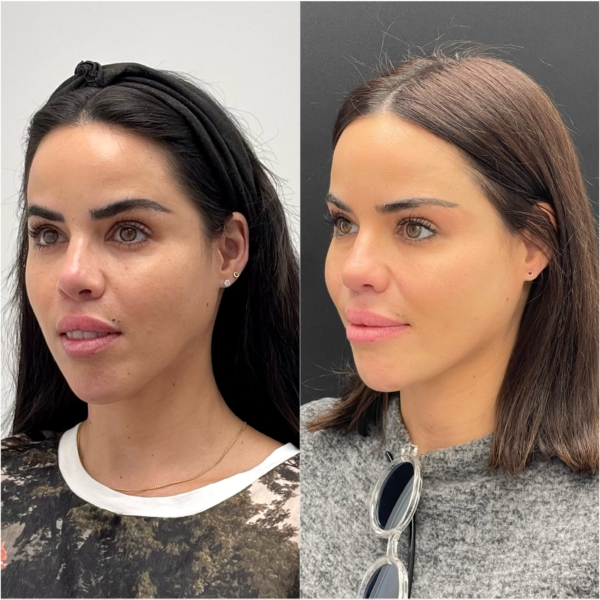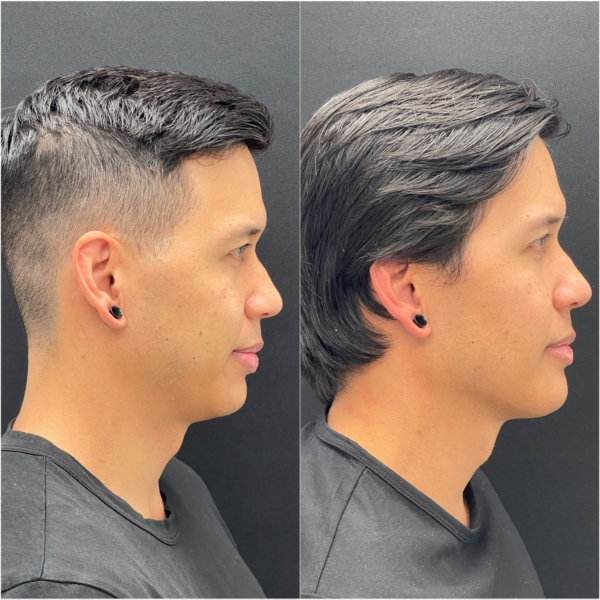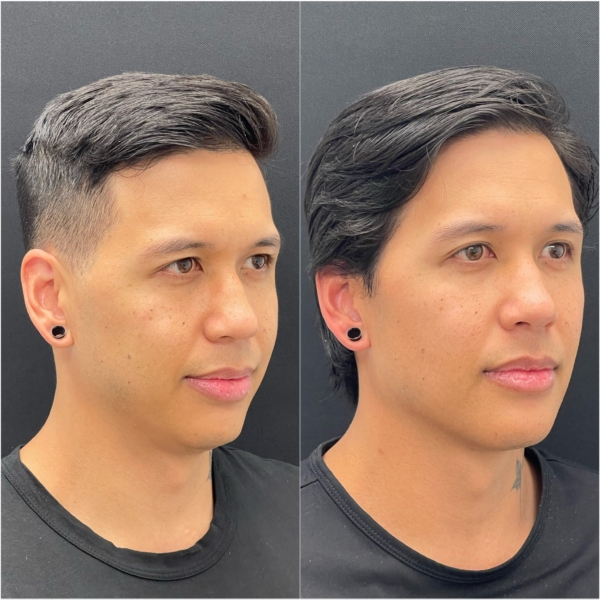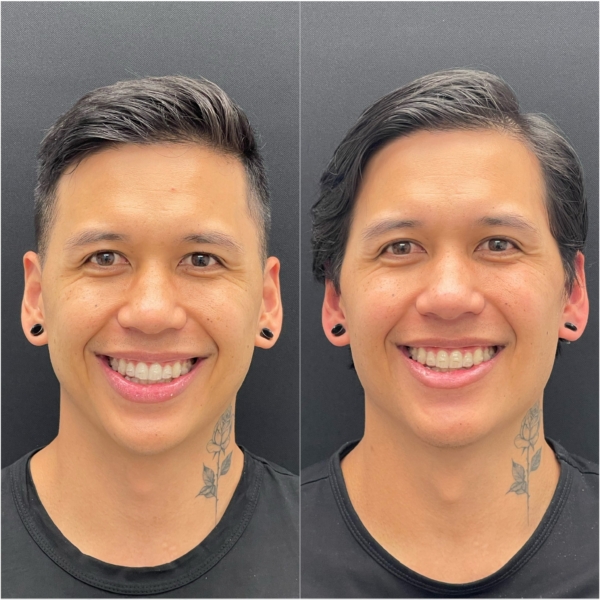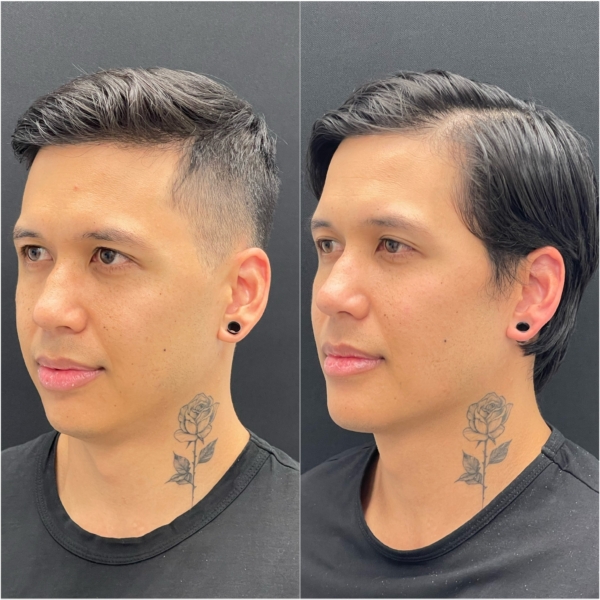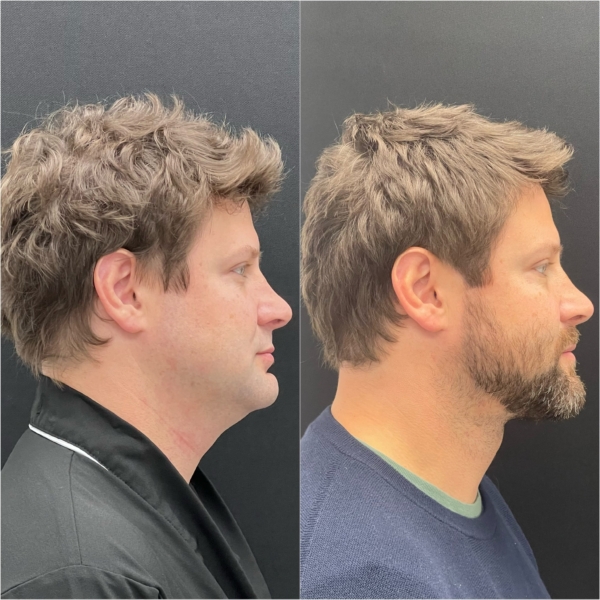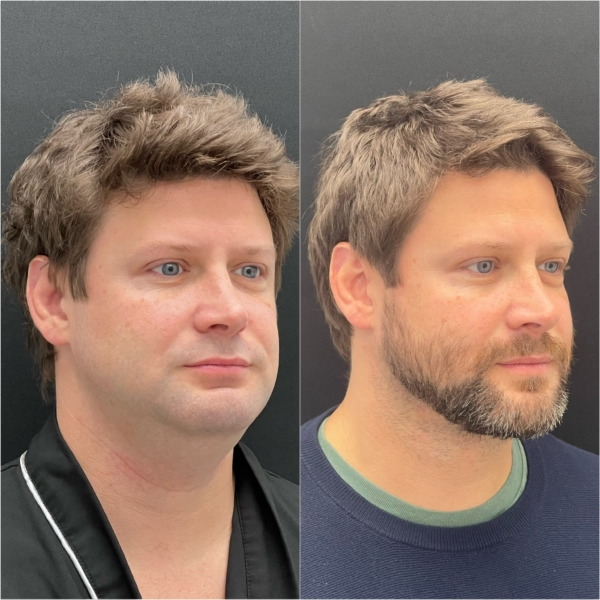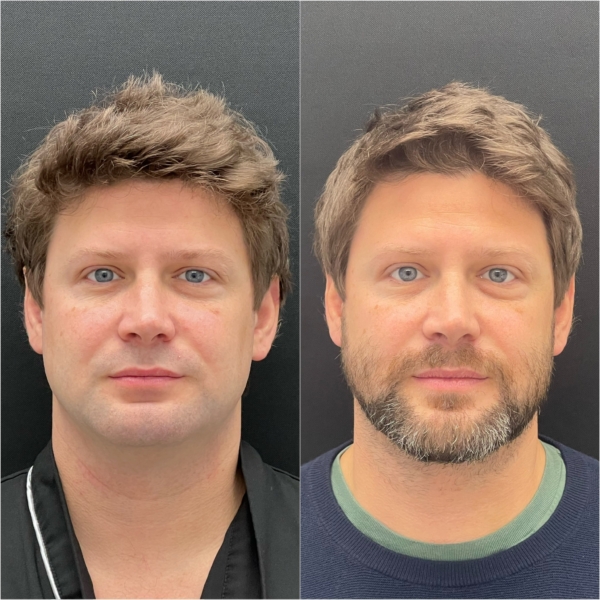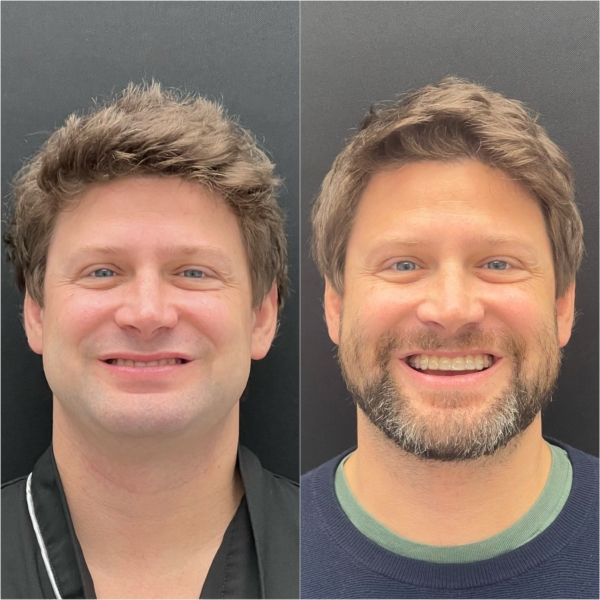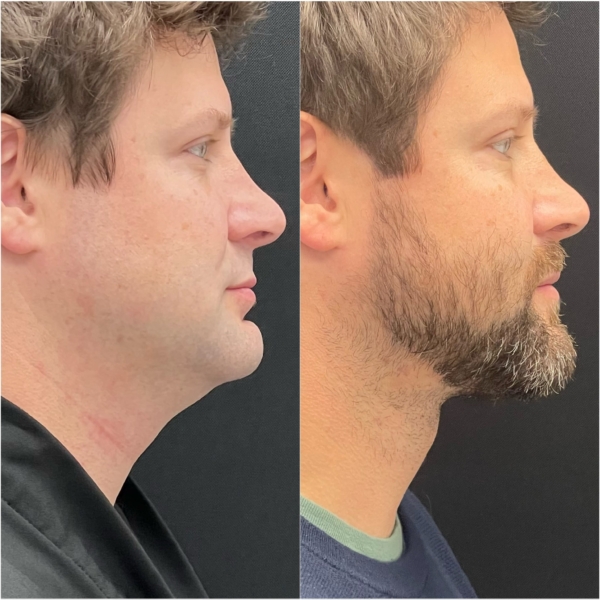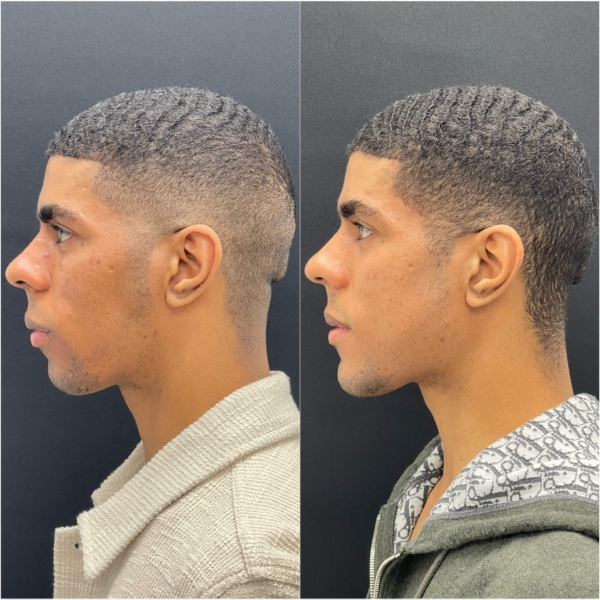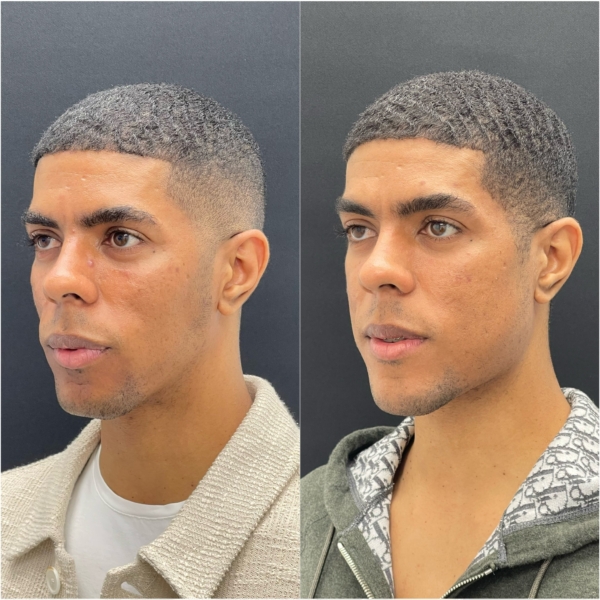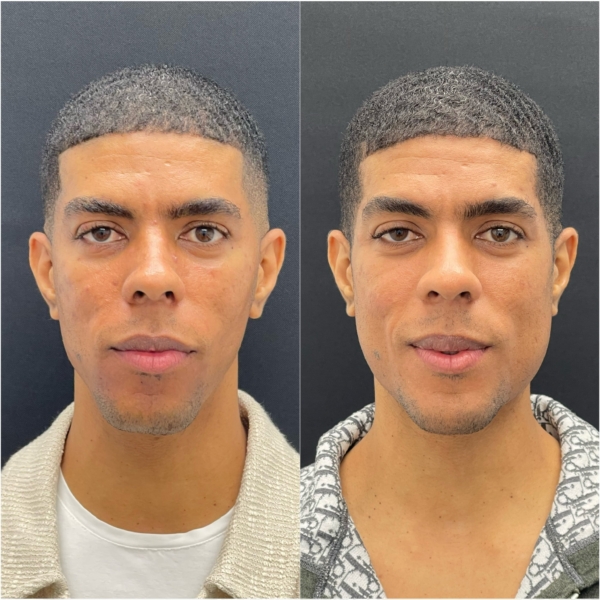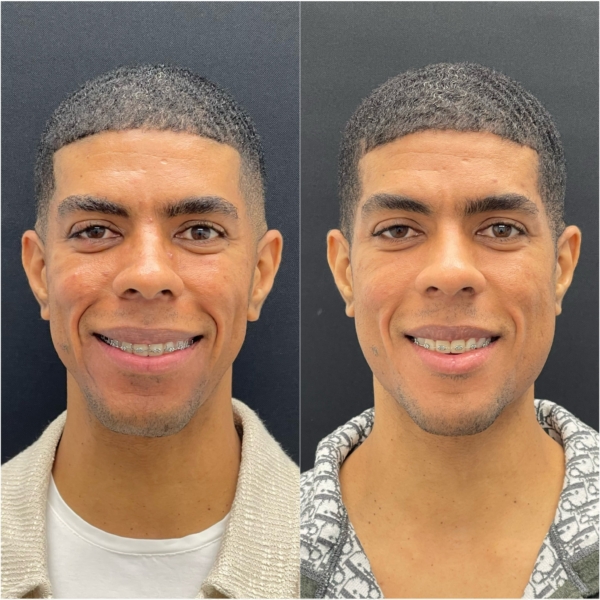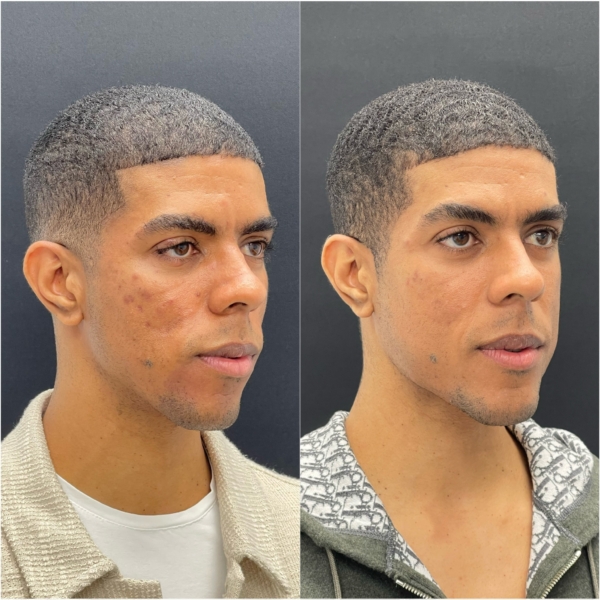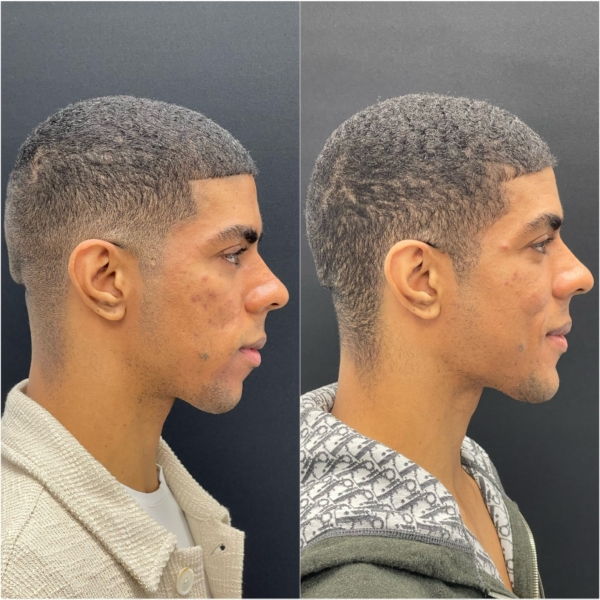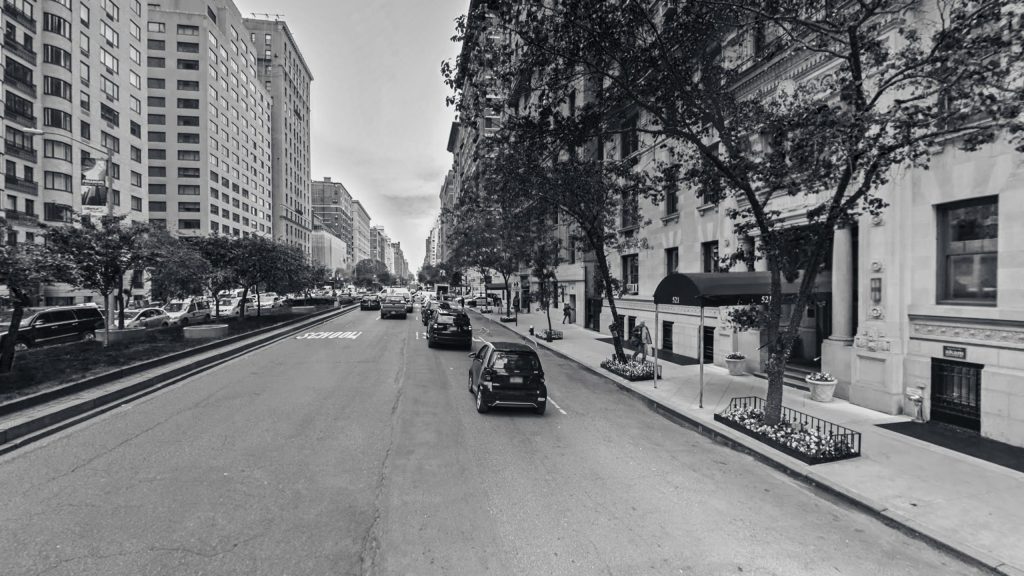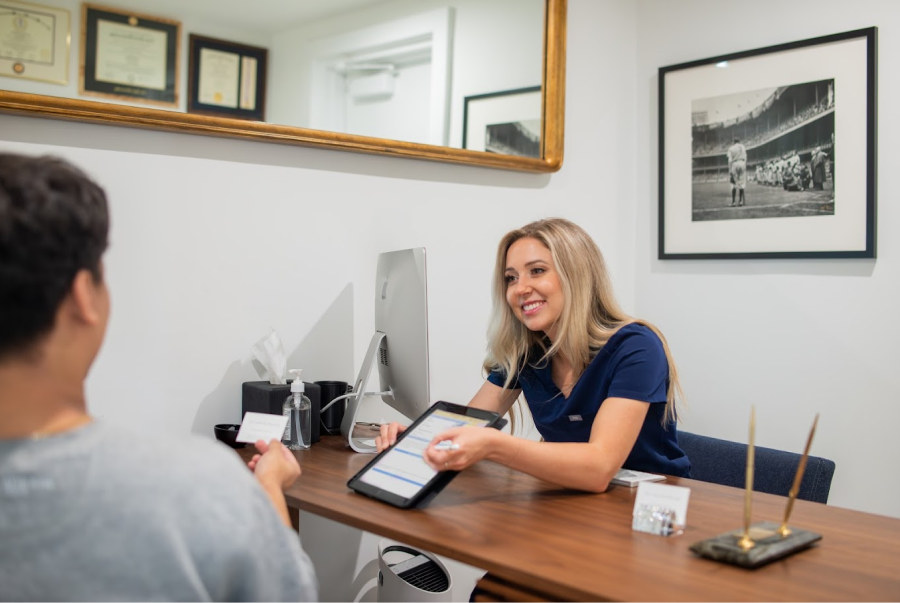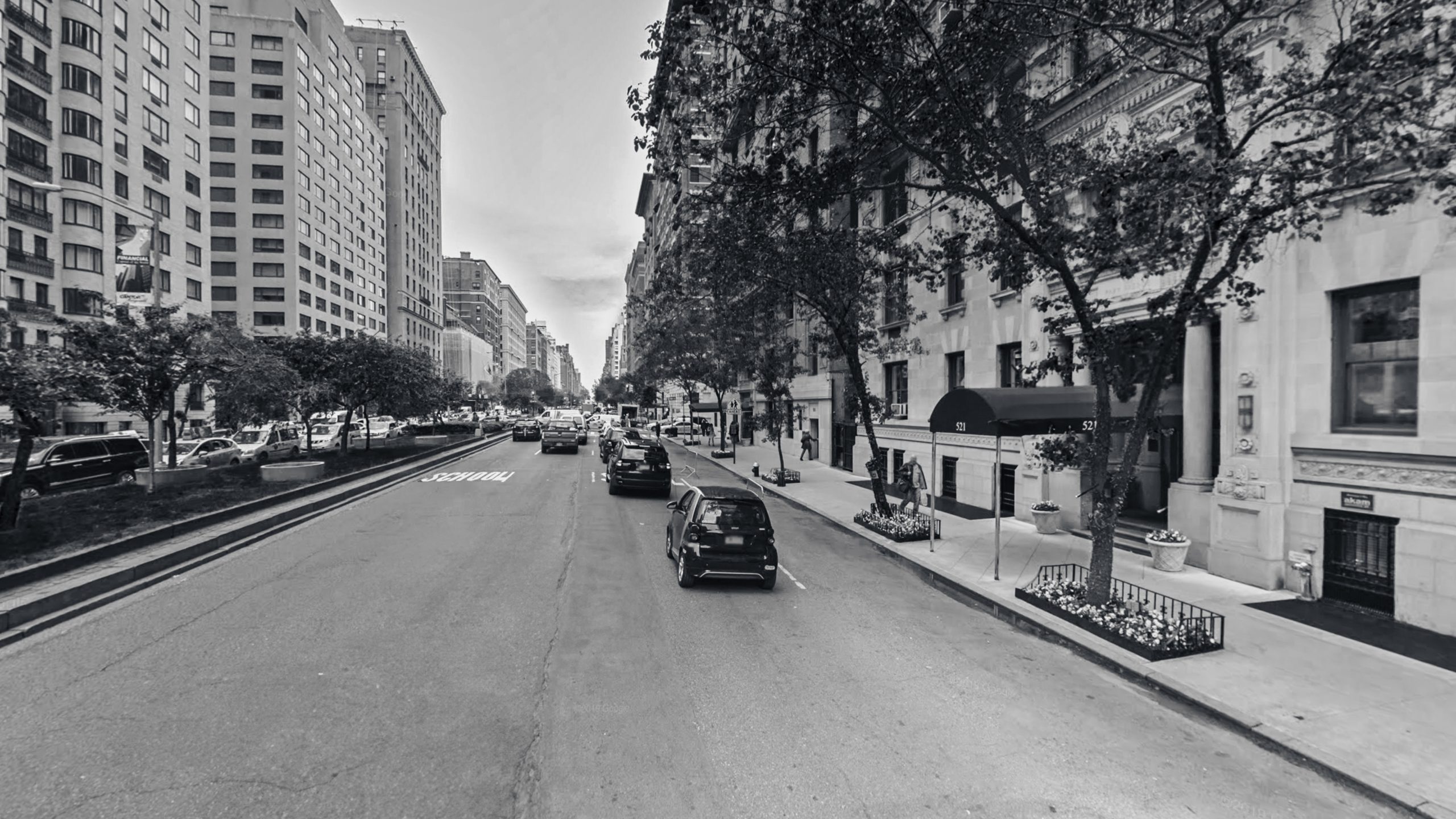
What is a genioplasty, and how does it compare to a chin implant?
A genioplasty is a surgical procedure that reshapes the chin by repositioning the chin bone itself, much like a rhinoplasty reshapes the nose. A genioplasty alters the size, position, shape, or symmetry of the chin to improve facial aesthetics and balance, and sometimes even function. A genioplasty can make a chin bigger or smaller, more forward or more backward, longer or shorter. Additionally, rotational movements can be used to enhance and control the soft tissue and muscle around the chin and in the fold between the lower lip and chin (labiomental fold).
This is in contrast to a chin implant, which is primarily used to increase size, add shape, and increase projection—only additive, not reductive. For all reductive movements, and for most larger additive movements, a genioplasty using custom hardware and virtual computer planning is superior to a chin implant.
A chin implant is used to enlarge or enhance the size and shape of the chin, and can be an excellent option in select cases. Chin implants are ideal for smaller additive augmentation—meaning they cannot make a chin smaller – and they should not be used for large advancements. They are also good options for small asymmetry corrections and restoring normal contour after bone has become irregular from prior surgery, tumors, or trauma. Custom PEEK chin implants that are designed via computer virtual planning are superior to other types.*
Both procedures can be used to balance facial proportions, enhance jawline definition, and help to support loose skin and soft tissue.
For both a custom genioplasty and a custom chin implant, advanced imaging techniques are used to plan the surgery and design the custom-made hardware (plates/screws) or custom implant for maximal precision and predictability.
Chin implants, like all facial implants, can be custom or non-custom (stock)**. A genioplasty can also be custom or non-custom depending on the hardware (surgical guides and titanium plates). Custom hardware and custom implants are both fabricated and designed from a patient’s CT scan, which we take in-office during the consultation. They are shaped and designed specifically for each patient’s anatomy and aesthetic goals. This virtual planning is done by computer and is reviewed with each patient along with predictive images before the custom material is made so we can get a very accurate idea of the end result. Adjustments can then be made to the design prior to production/fabrication as needed.
In our practice, access for a genioplasty or chin implant is almost exclusively made through the mouth (trans-oral). This avoids a visible scar under the chin and is typically safer. Numerous studies have shown no difference with infection rates when access is made through the mouth vs. through the facial skin.
*In our practice we only offer custom chin implants made with PEEK material.
**Non-custom (stock) implants are prefabricated in various shapes and sizes (eg. S,M,L) and do not require a CT scan or virtual planning. They have a generic shape that may or may not be suitable for most patients.
Patient Results
View before and after photos of our patients who had this procedure.
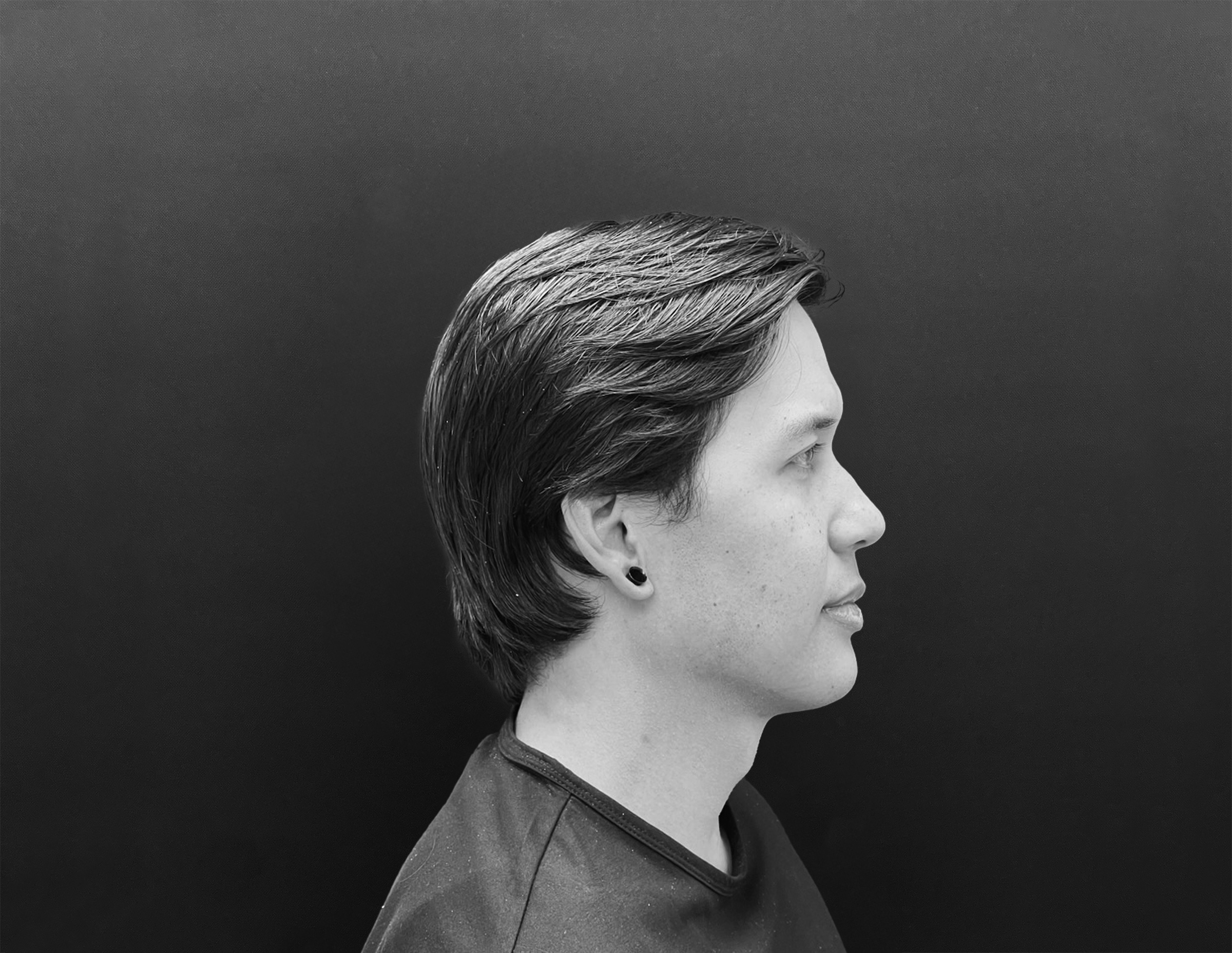
Benefits of
Chin Surgery
- Improved facial balance
- Improved jawline definition and/or symmetry
- Improvement of airway and obstructive sleep apnea (in some genioplasty cases)
- Improved bone structure in conjunction with face or neck lift, submentoplasty, or submental liposuction
- Minimal downtime, no scarring (all incisions hidden inside the mouth)
- Permanent results
How does a genioplasty or chin implant compare to using fillers in the chin area?
When the goal is to create bone structure, filler is not the best option for several reasons. It is a fluid gel material, so it does not lift or build structure, it “fills” like water fills a balloon. This creates a round jelly-like appearance of the skin in larger amounts. Many patients are satisfied with their fillers at first, but after 5-10 years of filler treatments, they feel their faces look swollen, round, heavy, or fat. They also can stay in the body for 10 years or more. Some literature suggests that large amounts injected over the years expands the skin and soft tissue, resulting in loose skin.
Why is a CT scan taken at the consultation?
A CT scan is required for proper diagnosis and evaluation of the bone structure so that the custom implants/hardware can be designed accurately. It is also needed to rule out any other complicating anatomical factors that would affect decisions regarding the treatment plan. In a genioplasty, there are also many different techniques in bone cut patterns that are specific for a patient’s bone structure, other anatomy, and aesthetic goals.
What are chin implants made of?
Common materials for chin implants include silicone, Medpor, titanium, and PEEK (polyetheretherketone). PEEK is considered the gold standard and is a solid but slightly flexible material that best simulates bone. It is highly biocompatible (accepted by the body without causing inflammation) and chemically stable so as not to corrode or break down. It is MRI-safe and radiolucent so as not to obscure future X-rays or imaging.
What are the different types of chin implants?
All facial implants can be custom or non-custom (stock).* Custom implants are fabricated and designed from a patient’s CT scan. They are shaped and designed specifically for each patient’s anatomy and aesthetic goals. This virtual planning is done by computer and is reviewed with each patient for adjustments. Non-custom (stock) implants are prefabricated in various shapes and sizes (S, M, L) and do not require a CT scan or virtual planning. In our practice we only offer custom PEEK chin implants.
Silicone can be custom, but usually is not. It is has a rubbery or gummy consistency. The flexible nature has mobility and causes rubbing against the underlying bone (even if it’s secured) causing erosion of the bone.
Medpor implants can also be custom but usually are not. They have small holes (pores) for tissue to grow into, which occurs progressively with time and can make removal very complex and damaging to the surrounding soft tissue. If you have to remove a Medpor implant, the sooner the better. We recommend avoiding them.
PEEK is a solid and smooth material that is always custom. These are always secured to the bone, and we feel they have the best surface characteristics, aesthetics, and functionality to simulate chin bone (or cheek bones and jaw angles). They can be removed easily and typically feel completely natural.
*In our practice we only offer custom facial implants and custom genioplasty.
What do chin implants feel like?
The most common answers from patients who have facial implants: “It feels like nothing.” “I don’t feel it.” “It feels like me.” “I can’t even tell that something there.” “It feels completely natural.”
What is the difference between a custom and non-custom chin implant or genioplasty?*
Chin implants, like all facial implants, can be custom or non-custom (stock). A genioplasty can also be custom or non-custom depending on the hardware (surgical guides and titanium plates). Stock chin implants are prefabricated in various shapes and sizes and selected to best match the patient’s anatomy and desired aesthetic; Stock hardware is modified during the genioplasty procedure to attempt to match the anatomy and desired chin aesthetic as closely as possible.
Conversely, custom hardware and custom implants are both fabricated and designed from a patient’s CT scan, which we take in-office during the consultation. They are shaped and designed specifically for each patient’s anatomy and aesthetic goals. This virtual planning is done by computer and is reviewed with each patient along with predictive images before the custom material is made so we can get a very accurate idea of the end result. Adjustments can then be made to the design prior to production/fabrication as needed.
*In our practice we only offer custom facial implants and custom genioplasty.
How can a genioplasty be “custom”?
Custom guided genioplasty can have different meanings. The way it is used in our practice describes a process where the surgery is performed virtually on a CT scan of the patient’s facial bones with soft tissue predictive images and sketches. When the desired facial aesthetic is achieved, the surgeon customizes the precise position of the bone cuts and custom-designs the titanium plates that will be used to fixate the bones into their desired positions. This is a highly accurate and precise method within 1-2mm of precision, allowing for smaller surgical access points (less invasive), quicker surgical times, more stable plate fixation, and therefore better results overall (aesthetically and functionally) than other methods.
Why was I recommended a genioplasty with jaw surgery?
Not every jaw surgery requires genioplasty; however, in most cases when the jaws are not ideally developed, the chin is also not ideally developed. Repositioning the chin bone at this time allows for an ideal profile and aesthetic bone structure. Also, many times with asymmetries of the jaw, there is also asymmetry at the chin, which needs to be corrected as well.
What type of anesthesia is used?
This is commonly done under a light “twilight” (IV) sedation. This allows you to remain comfortable and relaxed during the procedure.
How long does this surgery typically take?
1-2 hours
Do I need to stay overnight at the facility?
No; When a chin procedure is performed on its own, patients typically return home the same day.
Are there scars?
No. All incisions are inside the mouth. These incisions are placed in the deep folds of the mouth and are not visible once healed during speaking and smiling. We typically use sutures that dissolve on their own after a period of 1-2 weeks which do not require removal.
(When additional facial aesthetic procedures are performed, these may require separate skin incisions.)
What is the recovery time for genioplasty or chin implant placement?
Most patients can expect some swelling and bruising for the first week after surgery. Usually after one week, patients can resume work and normal daily activities. Within one week, typically 90% of the swelling and bruising has resolved. The remaining 10% of settling will occur over the next 3-6 months, or sometimes up to a year.
How long until I can be out in public?
Most patients can resume work (and are considered “restaurant-ready”) within one week. For social events such as weddings (guest), graduations, or holidays, one should allow at least two weeks for recovery.
How soon can I travel after my surgery?
We typically ask patients to remain in town for a period of one week before flying. However, car rides of 2-4 hours are ok the following day in most cases. (The surgeon would still like to see you for a post-op visit at the one-week mark.)
How soon can I see the results?
You will notice an immediate improvement after surgery, though swelling will obscure the final result initially. The majority of swelling typically resolves within the first week.
How do I choose the right surgeon for this procedure?
It is important to choose a surgeon who has: 1) The training and skill set in treating the maxillofacial structures, as well as soft tissue aesthetics of the face, head, and neck. Particularly valuable is the surgeons “fellowship” experience, which is elective higher level training performed after the standard residency training. Not every surgeon completes fellowship training. 2) An aesthetic sense that matches the patient’s.
What makes a chin enhancement surgery successful?
- Appropriate selection of procedure, material, and custom material design
- Stable and secure placement of hardware or implant with proper technique
- Addressing any related areas such as a heavy neck or sagging skin if present to enhance the appearance of the chin
- Achieving ideal balance of bone structure without over- or under-correction
Do facial implants or hardware set off airport metal detectors?
No.
Can I still safely get an MRI if I have facial implants or hardware?
Yes, no problem. Just let the technician know beforehand.
Do I need to have the hardware removed sometime after having a genioplasty procedure?
The hardware typically remains in place for life but can be removed if desired after a healing period of about 6 months once adequate bone healing has occurred.
Are chin implants safe?
Yes, chin implants are considered a very safe procedure when done properly. They have a very low infection and complication rate. Facial implants have been placed for several decades, so it is not a new procedure. Techniques and materials have continued to improve. They are not only used for cosmetic purposes, but also reconstructive purposes, near vital structures such as the eye, brain, and spine with excellent safety metrics.
What happens to chin implants as we age?
Essentially nothing; these implants are stable so they do not corrode or degrade. The added bone structure will offer better support to the soft tissue, so people will typically age better with less skin laxity (looseness) than they would have otherwise had.
What is the risk of infection or rejection for chin implants?
In global literature between 2-5%. In our practice it is less than 1%.
What happens if there’s an infection around the chin implant?
This can usually be treated with antibiotics alone. Sometimes a fluid collection is present and can be drained. In very rare cases the implant would be removed, we would wait 1-2 months to allow the infection to clear, and then a new implant can be placed.
What to Expect
After Surgery
- Most patients can resume work (and are considered “restaurant-ready”) within 5-7 days
- For social events such as weddings (guest), graduations, or holidays, one should allow at least 2 weeks for recovery
- Exercise: Very light activity such as a brisk walk or a light stationary bike is encouraged as soon as the patient feels ready for it after surgery. Moderate exercise is usually resumed in about one week and heavy exercise in 2-3 weeks
- 80-90% swelling is usually down by one week after surgery, 90-95% is down by 3 months, and the final 5-10% fades gradually over the course of a year
- Usually about 90% of swelling/bruising resolves within one week
- Sutures inside the mouth will dissolve on their own in about one week and will not need to be removed
- We will schedule follow-up appointments at typically one week, one month, 3 months, 6 months, and one year to take follow up CT scan imaging to ensure optimal healing. Some of these appointments can be virtual at the surgeon’s discretion for out of town patients
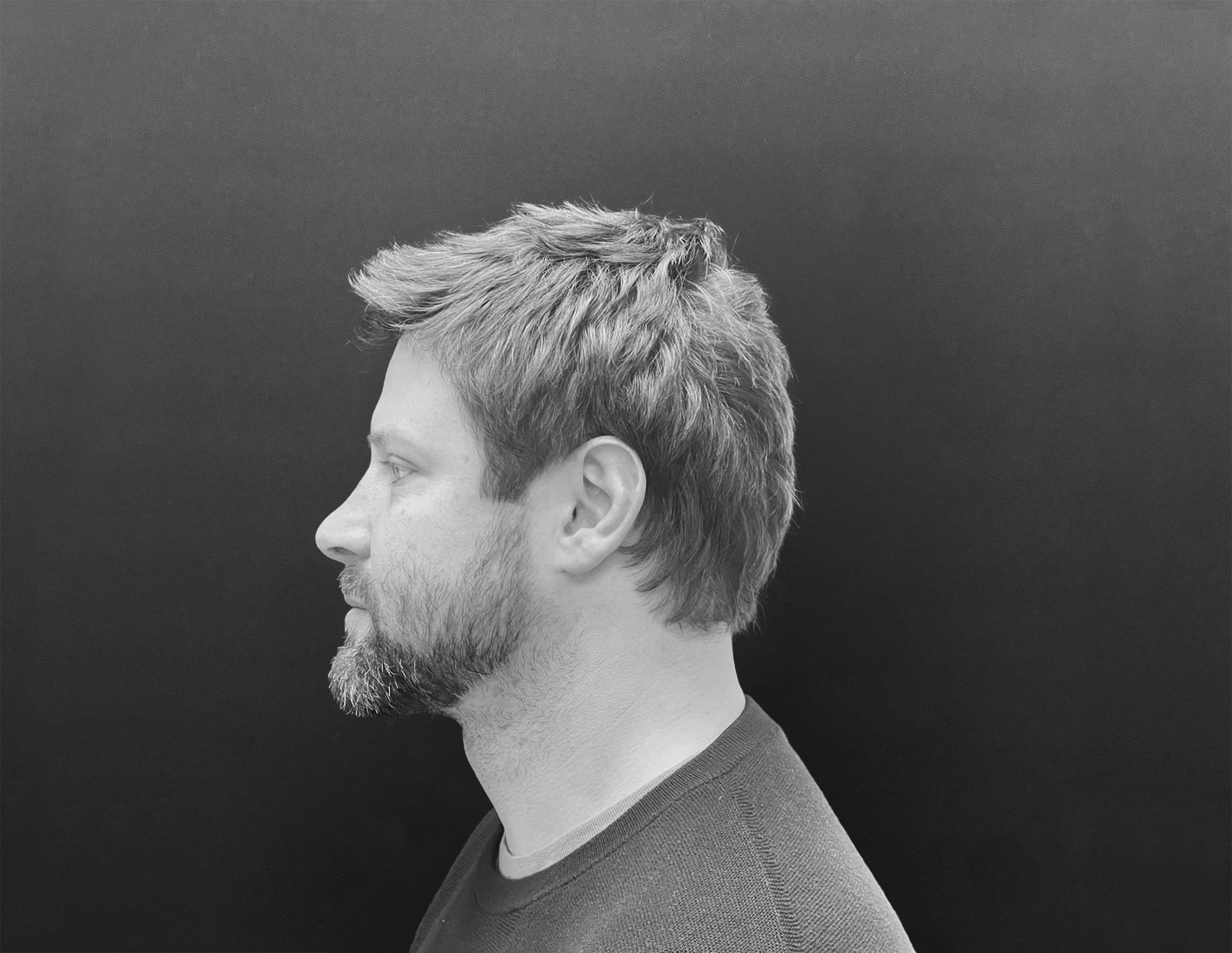
Custom vs. Non-Custom
Chin implants, like all facial implants, can be custom or non-custom (stock)*. A genioplasty can also be custom or non-custom depending on the hardware (surgical guides and titanium plates). Custom hardware and custom implants are both fabricated and designed from a patient’s CT scan, which we take in-office during the consultation. They are shaped and designed specifically for each patient’s anatomy and aesthetic goals. This virtual planning is done by computer and is reviewed with each patient along with predictive images before the custom material is made so we can get a very accurate idea of the end result. Adjustments can then be made to the design prior to production/fabrication as needed.
*Non-custom (stock) implants are prefabricated in various shapes and sizes (S, M, L) and do not require a CT scan or virtual planning. In our practice we only offer custom facial implants and custom genioplasty.
